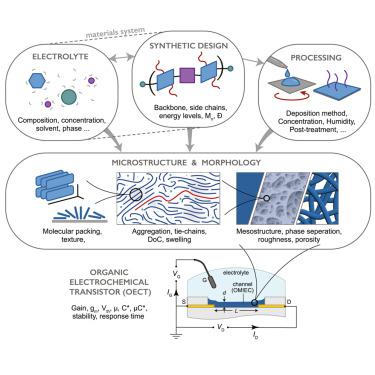Matter ( IF 17.3 ) Pub Date : 2023-05-24 , DOI: 10.1016/j.matt.2023.05.001 Joshua Tropp , Dilara Meli , Jonathan Rivnay

|
Organic electrochemical transistors (OECTs) have emerged as a powerful platform for bioelectronic communication, enabling various technologies including neuromorphic devices, stimulation elements, and biosensors. These devices leverage the ionic-electronic coupling of organic semiconductors, known as organic mixed ionic-electronic conductors (OMIECs), to transduce signals across biotic and abiotic interfaces or mimic biological functions. The efficiency and behavior of this ionic-electronic communication are material- and electrolyte-dependent; therefore, the utility of OECTs depends on our control over OMIECs within a particular environment. Here we critically review material design considerations for the next generation of mixed conductors for OECT applications. Recent advances and strategies toward high-performance p- and n-type OMIECs are summarized. Important topics, such as batch-to-batch variability, assessing stability, processing methodologies, and alternative material platforms, are also covered—areas rarely discussed within the OMIEC community. Challenges and opportunities related to these topics are discussed, offering a practical guide to designing the next generation of OMIECs for bioelectronic applications.
中文翻译:

用于电化学晶体管的有机混合导体
有机电化学晶体管(OECT)已成为生物电子通信的强大平台,支持各种技术,包括神经形态设备、刺激元件和生物传感器。这些设备利用有机半导体的离子电子耦合(称为有机混合离子电子导体(OMIEC))来跨生物和非生物界面转换信号或模拟生物功能。这种离子电子通信的效率和行为取决于材料和电解质。因此,OECT 的效用取决于我们在特定环境中对 OMIEC 的控制。在这里,我们严格审查用于 OECT 应用的下一代混合导体的材料设计注意事项。总结了高性能 p 型和 n 型 OMIEC 的最新进展和策略。还涵盖了重要主题,例如批次间差异、评估稳定性、加工方法和替代材料平台,这些领域在 OMIEC 社区中很少讨论。讨论了与这些主题相关的挑战和机遇,为设计用于生物电子应用的下一代 OMIEC 提供了实用指南。











































 京公网安备 11010802027423号
京公网安备 11010802027423号